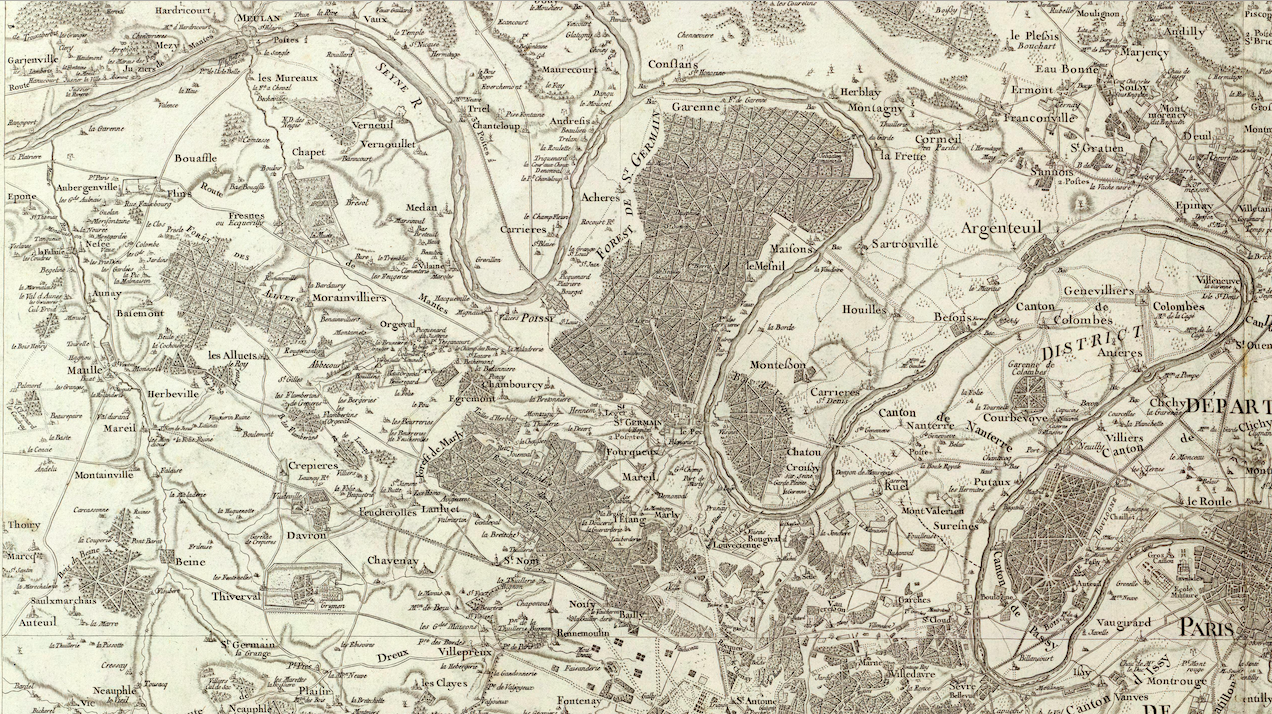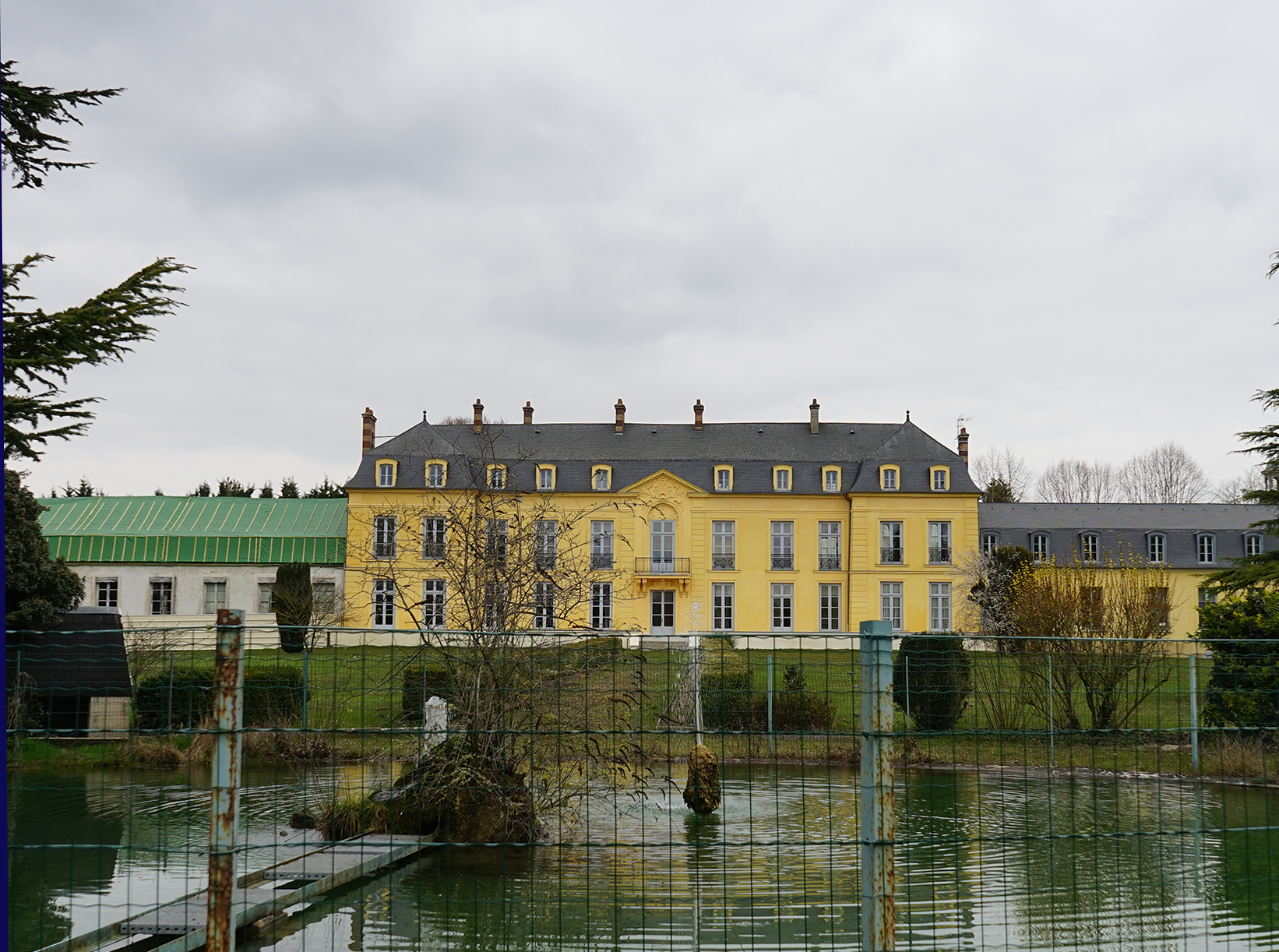Château Hanneucourt
In 1797, Théodore Géricault lived in Paris in the fashionable Faubourg Saint-Germain with his parents Georges-Nicolas Géricault and Marie-Jeanne-Louise Caruel, and his maternal grandmother Louise-Thérèse (de Poix) Caruel. The family had recently relocated from Rouen. Théodore was perhaps already studying at the pension Dubois & Loiseau on the Rue de Monsieur. Théodore’s father was working at the family tobacco enterprise at the Hôtel de Longueville on the opposite side of the Seine.
In 1797, Théodore Géricault’s family owned property in Normandy. However, no close family members owned property in Paris – despite the wealth the family began accumulating in 1791 from the manufacture and sale of tobacco and tobacco products. Théodore Géricault’s family leased their apartment on the Rue de l’Université; as did Géricault’s great-aunt and uncle living on the Rue de Belle Chasse, nearby. Théodore Géricault’s maternal uncle Jean-Baptiste Caruel and the family’s Robillard relations lived in apartments in that part of the Hôtel de Longueville leased to the family tobacco concern.
On January 23rd, 1797, this pattern changed when Jean-Baptiste Caruel, Géricault’s closest maternal uncle, purchased the Château d’Hanneucourt on the grande route from Paris to Rouen. No study of Jean-Bapiste Caruel’s purchase of this estate, houses, stables, woods, and farmlands has ever been made, as far as I can determine. In this article, I will confirm the purchase of the Château d’Hanneucourt by Jean-Baptiste Caruel in 1797 and begin my examination of the impact of this acquisition on Théodore Géricualt and his family.
Château d’Hanneucourt- Sale
In 1818, a Bourbon king once more sat on the throne of France. On January 21st, that king – Louis XVIII, granted Jean-Baptiste Caruel (écuyer) the right to add the family name of his wife Alexandrine-Modeste de Saint-Martin to his own and thus join the nobility. The following year, on November 9th, 1819, Louis XVIII made Jean-Baptiste Caruel de Saint Martin the Baron Favreuse. Scholars agree that Jean-Baptiste Caruel’s acquisition of a series of properties played a vital role in this ascent to the aristocracy. Our new understanding of the facts allows us to now, in hindsight, recognize Jean-Baptiste Caruel’s purchase of the Château d’Hanneucourt in 1797 as the first step of a long march towards ennoblement as Jean-Baptiste Caruel de Saint-Martin, and then Baron Favreuse.

The estate which Jean-Baptiste Caruel purchased on January 23rd, 1797, was identified in the purchase agreement simply as the la terre d’hanneucourt in the commune of Gargenville in the Canton of Limay, near Mantes, in the department of Seine et Oise. Feudal titles and references had been outlawed in 1792. However, perhaps as a sign of resurgent royalist sentiments in France in 1797, the château is identified as such on page one of the contract.
Jean-Baptiste Caruel purchased the terre d’hanneucourt from Daniel-Doumerc Belan and his wife Marie-Reine-Antionette Villamard, who maintained a residence in Paris at n° 31 rue de Mont Blanc. The Château d’Hanneucourt had been the seat of the Hanneucourt family for at least two generations. Doumerc Belan and his wife acquired a share of the property on July 5th, 1793 in an agreement with François-Lucien Ballot and Jean-Ferdinand-Elie Randon d’Hanneucourt. Randon d’Hanneucourt appears to have relinquished his share of the property first, followed by Ballot on October 7th, 1796. The purchase agreement of January 23, 1797, identifies Doumerc Belan and Villamard as the sole owners of the estate.
Property is divided into mobiliers and immobiliers – property that can be moved and property such as land and buildings which cannot. The value of the mobiliers: goods, tools, furniture, etc. was set by outside appraisers at 40,000 livres, and the value of land and buildings at 200,000 livres, for a toal of 240,000 livres, including rents. Jean-Baptiste Caruel provided a downpayment of 100,000 livres, with the balance to be paid at a later date.
The contract is a fascinating piece of history. The agreement names the tenant farmers and their rents, and includes a description of all mobiliers and immobiliers. Among the most interesting items, for me, are the chapel (above) and the orangerie below. The estate chapel (item 82) was valued at 60 livres. The orangerie (item 107,) which occupied one wing of the château, and the estate’s orange trees were together valued at 10,000 livres. The ancien orangerie (item 102) was valued at just 25 livres. I will have more to say about this contract elsewhere. Let us now situate the Château Hanneucourt and Gargenville on the map.
Gargenville – Paris

1762 Cassini Map Plate One (detail). Image courtesy of David Rumsey maps.
The Cassini map above and below allows us to get some sense of size and space west of Paris in 1762. Paris is clearly visible in the lower right corner of the map. Roule, the site of the Hôtel du Roule (discussed elsewhere) is visible just north of Paris in the lower right corner of this plate. Géricault’s family residence in 1797 lay on the south side of the Seyne (Seine), almost directly below Roule, and very close to the river on this map.
The Seyne loops and winds from Géricault’s home in Paris to the top left hand corner of the plate. Gargenville, roughly 45 kilometers distant, can be seen in the extreme top left corner above. Hanucourt (sic) is not easily visible, but can be seen easily in the larger scale section of the same map below. Rouen, Géricault’s place of birth, lies a further 100 kilometers from Gargenville towards the north-west.

Hanucourt (sic) – 1762 Cassini Map Plate One (detail). Image courtesy of David Rumsey maps.
Commentary
Théodore Géricault visited the Château Hânneucourt with his family, almost certainly, sometime in 1797, or 1798. Property mattered, and not just to the Géricault/Caruel family. The purchase of an estate such as this is an event few experience. Louise-Thérèse De Poix would have been especially proud. Jean-Baptiste Caruel was her second son. Her first son and eldest child François-Jean-Louis Caruel was a pariah, of sorts, who would die in poverty in Paris in 1805. Her husband Jean-Vincent-Charles Caruel died in a maison de force (mental hospital) in 1779. Jean-Baptiste Caruel was the stereotype of the ideal son, and the ideal brother to three sisters. In 1775, he was winning academic prizes in Rouen (Annonces, Affiches et Avis Divers de la Haute et Basse-Normandie, 1775 08 18). He succeeded in a variety of arenas, won the respect of his peers, and was ideally suited to become a founding partner of the family tobacco concern at Hôtel de Longueville and accumulate real wealth.
Jean-Baptiste Caruel’s acquisition of the Château Hânneucourt in January, 1797, was manifest evidence of these abilities and a public statement of his own success and that of his family. Théodore Géricault was a child in January, 1797, however, when six months was part of a lifetime – when seasons, more than dates, marked change. To Théodore, Hanneucourt would register as a “thing” – a new space – very grand, and important to his parents and relations in large part because it was “ours.” Even an only child like Théodore grasps the idea of ownership easily. Hanneucourt was immense, organic, marvelous – buildings, sights, smells, and gardens of value and significance to those Théodore loved most. Over time, he would observe the deference paid his uncle, and to other family members, by domestics, renters, and tradesmen of different types. Did Théodore wonder why?
In 1797, at home and at school Théodore Géricault was surrounded by an opulence and grandeur very different from the family home in Rouen, and those of relations in rural Normandy, the only worlds Théodore had ever known. That same summer of 1797 Théodore would also meet his relations from Saint-Domingue, cousins who were raised on plantations in lush, far-off places that Théodore could barely imagine. Hanneucourt, in stark contrast, was concrete, a place he could he enter, run through, and touch – a part of “home” – where the family miraculously had orange trees of their own.
In 1797, Jean-Baptiste’s purchase of the Château d’Hanneucourt confirmed that Théodore Géricault was living in a different world; the whole Géricault family was. His relationship with his uncle Jean-Baptiste Caruel would continue to evolve and grow as both matured – until it shattered completely, in 1818, as both men stood on the cusp of public acclaim and personal triumph.
Château D’Hanneucourt (Today)

The Château d’Hanneucourt today is both a private commercial property and a heritage site. We can be grateful that the current owners and the municipality of Gargenville have elected to preserve as much of the original property as possible. The actual estate with farmlands and woods in 1797, of course, was far larger. The video below allows us to step into that greenhouse space today.
The video by AXA and the municipality of Gargenville is also available on Youtube. Readers may wish to adjust the settings for subtitles and speed of the narration. AXA has played a major part in protecting and restoring important heritage sites in France. We are in their debt.